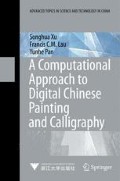Abstract
In this chapter we will introduce a novel intelligent system which can automatically generate new Chinese calligraphic artwork to meet visually aesthetic requirements. The system first extracts the hierarchical parametric representations of Chinese characters from input images of existing calligraphic style to form a compact set of training examples. Using a six-layer hierarchical representation, the extraction results are stored in a small structural stroke database, which are then exploited to form a continuous calligraphy knowledge space. The space is spanned by character examples of different styles (knowledge sources) which are aggregated and aligned according to a proposed constraint-based analogous reasoning process. By also incorporating a set of simple and yet effective geometric constraints, the proposed system can generate novel calligraphic styles that are aesthetically appealing. Samples of novel calligraphic artwork produced using the system are presented to demonstrate the effectiveness of our approach. The combination of knowledge from various input sources creates a huge space for the intelligent system to explore and produce new styles of calligraphy. Possible applications of the proposed system are also discussed.
Access this chapter
Tax calculation will be finalised at checkout
Purchases are for personal use only
Preview
Unable to display preview. Download preview PDF.
References
Harry Blum. A transformation for extracting new descriptors of shape. Models for the Perception of Speech and Visual Form, (ed. Wathen-Dunn, W.), 10(2):362–380, 1967.
Yap S. Chua. Bézier brushstrokes. Computer-Aided Design, 22(9): 556–573, 1990.
Kwok-Wai Cheung, Dit-Yan Yeung, and Roland T. Chin. A Bayesian framework for deformable pattern recognition with application to handwritten character recognition. IEEE Transactions on Pattern Analysis and Machine Intelligence, 20(12):1382–1388, 1998.
Rong He and Hong Yan. Stroke extraction as pre-processing step to improve thinning results of Chinese characters. Pattern Recogn. Lett., 21(8):817–825, 2000.
Mark Keane. Analogical mechanisms. Artificial Intelligence Review, 2(4):229–250, 1988.
Donald E. Knuth. Tex and Metafont: New Directions in Typesetting. American Mathematical Society, and Bedford, MA, USA: Digital Press, Providence, RI, 1979.
H.M. Lee, C. W. Huang, and C.C. Sheu. A fuzzy rule-based system for handwritten Chinese characters recognition based on radical extraction. Fuzzy Sets and Systems, 100(1–3):59–70, 1998.
Tomoyuki Nishita, Shinichi Takita, and Eihachiro Nakamae. A display algorithm of brush strokes using Bézier functions. In CGI’93: Proceedings of CG International, Lausanne, Switzerland: Springer-Verlag, pages 244–257, 1993.
Zhigeng Pan, Xiaohu Ma, Mingmin Zhang, and Jiaoying Shi. Chinese font composition method based on algebraic system of geometric shapes. Computers and Graphics, 21(3):321–328, 1997.
Geber Ramalho and Jean-Gabriel Ganascia. Simulating creativity in jazz performance. In AAAI’ 94: Proceedings of the Twelfth National Conference on Artificial Intelligence, Menlo Park, CA, USA: American Association for Artificial Intelligence, volume 1, pages 108–113, 1994.
Herbert A. Simon. Style in design. Spatial Synthesis in Computer-Aided Building Design, ed. Charles M. Eastman, pages 287–309, 1975.
Steve Strassmann. Hairy brushes. In SIGGRAPH’ 86: Proceedings of the 13th Annual Conference on Computer Graphics and Interactive Techniques, Dallas, TX, USA: ACM Press, pages 225–232, 1986.
Songhua Xu, Min Tang, Francis CM. Lau, and Yunhe Pan. A solid model based virtual hairy brush. Computer Graphics Forum (Proceedings of Eurographics’ 02), 21(3):299–308 & 625, 2002.
Songhua Xu, Min Tang, Francis CM. Lau, and Yunhe Pan. Virtual hairy brush for painterly rendering. Graphical Models, 66(5):263–302, 2004.
Berrin A. Yanikoglu and Peter A. Sandon. Recognizing off-line cursive handwriting. In Proc. Computer Vision and Pattern Recognition, Seattle, WA, USA: IEEE Computer Society, pages 397–403, 1994.
Pengfei Zhu and Paul M. Chirlian. On critical point detection of digital shapes. IEEE Transactions on Pattern Analysis and Machine Intelligence, 17(8):737–748, 1995.
Rights and permissions
Copyright information
© 2009 Zhejiang University Press, Hangzhou and Springer-Verlag GmbH Berlin Heidelberg
About this chapter
Cite this chapter
(2009). Principles of Automatic Generation of Artistic Chinese Calligraphy. In: A Computational Approach to Digital Chinese Painting and Calligraphy. Advanced Topics in Science and Technology in China. Springer, Berlin, Heidelberg. https://doi.org/10.1007/978-3-540-88148-3_8
Download citation
DOI: https://doi.org/10.1007/978-3-540-88148-3_8
Publisher Name: Springer, Berlin, Heidelberg
Print ISBN: 978-3-540-88147-6
Online ISBN: 978-3-540-88148-3
eBook Packages: Computer ScienceComputer Science (R0)

